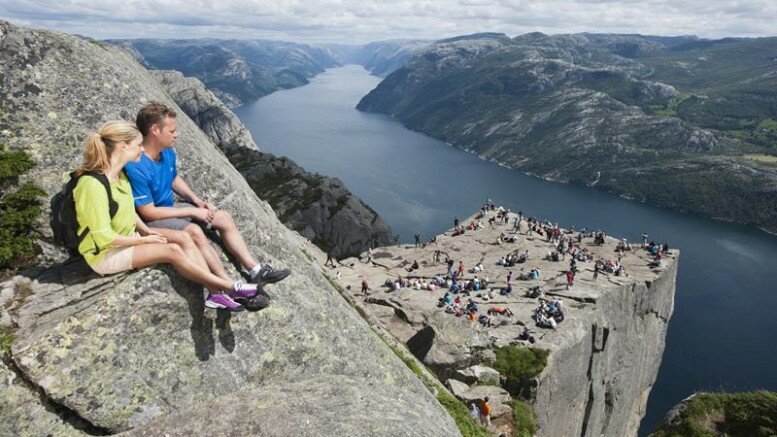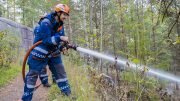The Hitchhikers guide to the Pulpit Rock
The Pulpit Rock has been voted one of the world’s most spectacular views, both by CNN Go and Lonely Planet.
The flat mountain plateau is Norway’s most famous natural attraction. Many have it on their own «bucket list» – Things to do before you die. It is popular to take a selfie on the edge of the 604-metre sheer drop down to the Lyse Fjord. Below is the spectacular hike presented in 12 minutes.
Distance to the Pulpit Rock parking place
The Pulpit Rock parking lot is located at Refsvatnet and the Pulpit Rock mountain lodge.
From Stavanger via the ferry to Tau in Ryfylke, the drive takes about 1 hour and 15 minutes by car. Several bus companies run shuttle traffic from Tau to the Pulpit Rock area in the main season.
From Sandnes via the ferry connection Oanes-Lauvvik, the drive takes about 1 hour 15 minutes by car or bus.
In 2019, Ryfast – The world’s longest and deepest subsea road tunnel opens for traffic – and the travel time will then be about 30-35 minutes from Stavanger.
Parking
The car park is serviced throughout the year. Parking fee:
- NOK 200 for regular cars (
- NOK 100 for motorcycles.
- NOK 800 for buses.
Hire of clothes, footwear, spiked shoes and other necessary equipment is available at the Pulpit Rock Mountain Lodge. There are a tourist information and sanitary facilities at the parking lot.
Short about the trip
Length: 3.7 kilometres walk to the plateau.
Travel time: Cirka 2 hours each way.
Height difference: 350 metres.
The only way (bar helicopter) you can experience the Pulpit Rock is by using the horse of the Apostles. Remember to don good footwear and warm clothes. Bring food and drink along. the Pulpit Rock Foundation issues the current weather conditions on Facebook.
The trail runs through uneven hilly terrain and there are good ponds for bathing (weather and temperature permitting) and resting places along the trail.
The tour of the Lyse Fjord
The hike usually starts from the Pulpit Rock parking at the mountain lodge. If you want bigger challenges, it is also possible to take a boat into Lysefjorden and start the trip, either from Refså quay, Bratteli, the Bakken (hill) farm or Songesand. These trails are part of the tour of the Lyse Fjord, which the Stavanger Tourist Association are responsible for.
Adapted trail
The trail consists of three climbs in the first half of the hike. Here you also pass the Kroge Stream marsh (Krogebekkmyra), where there are laid out railway sleepers to walk on. When you reach the top of the Neverdalskaret you have reached the halfway mark, from then on it is easily traversable terrain. First along the cliffs where you look down into Neverdalen. Then past Tjødnane, where many tourists stop for a dip in the water. And finally along the Lyse Fjord before you end up at the spectacular vista.
The substrate is mostly grey granite. Whether you cross mountainous stretches polished by glaciers 10,000 years ago, or on stone steps made by Sherpa’s from Nepal to withstand a large number of visitors.
Along the way you pass milestones, showing how far you have travelled and how far it is left to the destination.
Hotel and lodging
The Pulpit Rock Mountain Lodge is located at the beginning of the main trail. The Works Hotel at Jørpeland and Lilland Brewery Hotel in Tau are other alternatives. Besides those, there are several Airbnb offers in Jørpeland and Tau.
Food & Drink
The Pulpit Rock Mountain Lodge, The Works Hotel and Lilland Brewery Hotel all have restaurants. At Jørpeland there is the Rose garden (Rosehagen), several Chinese restaurants and a number of other eateries.
Mission: Impossible – Fallout
The final scene in «Mission: Impossible – Fallout» was recorded on the Pulpit Rock. Tom Cruise and Henry Cavill fight on the edge of the drop after crashing with a helicopter. (No, it did not take place in Kashmir).
The history of the Pulpit Rock
The Pulpit Rock itself was formed by nature 10,000 years ago. At that time there was a glacier in the Lyse Fjord pressing on the mountain. Water penetrated into the rocks of the bedrock, the water then froze to ice and blasted away loose granite blocks to form the unique rock formation.
In the old days, the rock cropping was named Hyvlatonnå (Grader’s tooth), after the steel that protrudes from the base of a grader. But seen from below, Captain Hana on the freight ship DS «Oscar II», thought that it resembled a Pulpit.
The cliff was discovered by a bank manager in Stavanger, Thomas P. Randulff, in 1896. It was the start of the tourist traffic, and the destination was fast becoming known as the Pulpit Rock.
In case of emergency
- 110 – Fire
- 112 – Police
- 113 – Ambulance
At Tjødnane there is a security cabin where it is possible to seek shelter in case of a crisis.
On a hike in the mountain world, you are responsible for your own safety. It is imperative to consider weather conditions at all times, they may change very rapidly in the mountains! Nobody should start the hike when there is a risk of darkness before reaching your overnight destination. Don’t hesitate to bring along head torches, staves and spiked shoes under dark and slippery conditions.
Remember always: Tell someone when and where you are going, and when you are expecting to be back.
There is no shame in turning back!
Experience the Pulpit Rock from the Lyse Fjord
If you want to experience the Pulpit Rock seen from the fjord, there are day cruises between Lauvvik, Forsand, Songesand and Lysebotn in the summer. Other alternatives are sightseeing boats from Stavanger or the combined ferry MS «Lysefjord», which is in regular service.
Sightseeing: www.norled.no and www.rodne.no
Combi ferry MS «Lysefjord»: bestilling.kolumbus.no
Tourist ferry: www.thefjords.no
More photos etc. available here.
© Aftenbladet.no / #Norway Today





